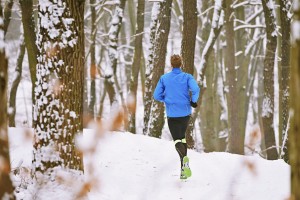Cold Weather Training
by guest contributor, Dr. Dan Shuman
 Cold Weather Training – Tis the season when clocks fall back, daylight diminishes, and the snooze button becomes more alluring than hitting the chilly pavement. A lot of patients express that they don’t feel like themselves during this time of year. Even for the normally optimistic crowd, the winter blues are common when temperatures drop because there is less exposure to the sun. To make things worse, it seems there are endless parties, events, and obligations that can take time away from training. This article will provide some suggestions to combat the weather and keep you on pace with your training goals.
Cold Weather Training – Tis the season when clocks fall back, daylight diminishes, and the snooze button becomes more alluring than hitting the chilly pavement. A lot of patients express that they don’t feel like themselves during this time of year. Even for the normally optimistic crowd, the winter blues are common when temperatures drop because there is less exposure to the sun. To make things worse, it seems there are endless parties, events, and obligations that can take time away from training. This article will provide some suggestions to combat the weather and keep you on pace with your training goals.
One of the first obstacles to continued training is obviously the temperature change. Luckily here in Atlanta, there are only a few months out of the year where one really needs to be concerned with less than optimal temperatures. Still there are a couple things that a person can do to maximize training efforts and comfort levels. A really good rule of thumb is to dress like it is 20 degrees warmer than the current outside temperature. Another rule to abide by is to avoid wearing cotton as a base layer. Cotton absorbs sweat, which cools the skin. Sweat is the enemy when it comes to staying warm and can rob heat from the body up to 25 times faster. Instead, stick with a microfiber or wicking fabric that keeps the moisture off the body more effectively. If training in the mornings or evening, always dress to be seen. Pick up a couple of reflective coverings like a vest or jacket as well as a light-weight red flashing light that can be clipped to a belt or waist.
Another obstacle in winter training is muscle tightness and inflexibility. It takes longer for the muscles to get warmed up in the colder weather resulting in an increased risk of injury if intensity or volume goes up even slightly. A lot of people warm up their car in the winter months but fail to warm up their bodies adequately. Perform at least a five-minute warmup consisting of dynamic stretching for the entire body. Athletes should be just on the brink of sweating just before the start of the run or bike. Once it has begun, run or ride into the wind which will prevent sweating too much too quickly.
From a wellness perspective, it’s prudent to increase vitamin D intake in the winter months since most people are not getting sun exposure during the day. Vitamin D is a nutrient with broad and expanded benefits linked specifically to bone health as well as supporting roles in digestive and immune health. Most individuals can safely supplement 2,000 IU of D3 a day without any adverse side effects. This will help keep you feeling mentally fit and ready to battle the winter blues. Just be sure you aren’t taking any prescription drugs or have a condition that might be affected by increased intake of vitamin D.1
Finally, backing off a bit in the winter can be restoring. There is a value in slowing down. Increasing recovery times, especially in winter can help prevent injuries. Cross training is especially important to work out muscle imbalances and flexibility issues sustained during the competitive season. Substituting a yoga class for one of your weekly runs, cutting back total mileage and spending extra time strengthening the core and lateral muscles in the hips will likely contribute to faster times come spring. If a functional core program isn’t already in place, don’t do what everyone else is doing in the gym! Chances are, they are strengthening few muscles groups in an isolated way that will not be beneficial for athletic performance. Consult a professional who can recommend a good off-season training program and stay warm out there!
1For more information regarding Vitamin D, its benefits and possible risks, click here.
Decatur Office
2545 Lawrenceville Hwy
Suite 100
Decatur, GA 30033
404-377-0011
Johns Creek Office
9810-B Medlock Bridge Rd
Suite 104
Johns Creek, GA 30097
404-300-9931
